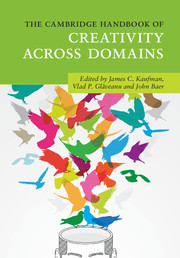Book contents
- The Cambridge Handbook of Creativity Across Domains
- The Cambridge Handbook of Creativity Across Domains
- Copyright page
- Dedication
- Contents
- Figures
- Tables
- Contributors
- Acknowledgments
- Part I Creativity and Domain
- Part II Creativity in the Traditional Arts
- Part III Creativity in the Sciences
- 12 Creativity in the Physical Sciences
- 13 Biomedicine, Creativity, and the Story of AIDS
- 14 Creativity in Psychology
- 15 Creativity in the Engineering Domain
- 16 Creativity in the Domain of Mathematics
- 17 Creativity Within Computer Science
- Part IV Creativity in Business
- Part V Newer Domains for Creativity Research
- Part VI Creativity in Everyday Life
- Part VII Conclusion
- Index
- References
16 - Creativity in the Domain of Mathematics
from Part III - Creativity in the Sciences
Published online by Cambridge University Press: 15 September 2017
- The Cambridge Handbook of Creativity Across Domains
- The Cambridge Handbook of Creativity Across Domains
- Copyright page
- Dedication
- Contents
- Figures
- Tables
- Contributors
- Acknowledgments
- Part I Creativity and Domain
- Part II Creativity in the Traditional Arts
- Part III Creativity in the Sciences
- 12 Creativity in the Physical Sciences
- 13 Biomedicine, Creativity, and the Story of AIDS
- 14 Creativity in Psychology
- 15 Creativity in the Engineering Domain
- 16 Creativity in the Domain of Mathematics
- 17 Creativity Within Computer Science
- Part IV Creativity in Business
- Part V Newer Domains for Creativity Research
- Part VI Creativity in Everyday Life
- Part VII Conclusion
- Index
- References
Summary
In this chapter, we first review mathematical creativity with an emphasis on the nature of novelty in mathematics. We compare mathematical creativity to creativity in other domains, provide examples of novelty, and contrast these to novelty in other domains and explain types of creativity in mathematics based on perspectives in philosophy. All the theoretical perspectives we reviewed led us to synthesize that mathematical creativity involves knowledge production which is either discovery or invention. The chapter also covers pioneers and their contributions to the study of mathematical creativity, such as Polya and Krutetskii. The last part of the chapter includes a review and critique of the assessment of mathematical creativity, such as paper and pencil assessments, observations and interviews, and self-assessment.
- Type
- Chapter
- Information
- The Cambridge Handbook of Creativity across Domains , pp. 276 - 298Publisher: Cambridge University PressPrint publication year: 2017
References
- 6
- Cited by



